2025人教版八年级英语下册Unit 2 Section B单词词汇课件
文档属性
| 名称 | 2025人教版八年级英语下册Unit 2 Section B单词词汇课件 |  | |
| 格式 | pptx | ||
| 文件大小 | 6.1MB | ||
| 资源类型 | 试卷 | ||
| 版本资源 | 人教新目标(Go for it)版 | ||
| 科目 | 英语 | ||
| 更新时间 | 2025-03-30 21:40:00 | ||
图片预览

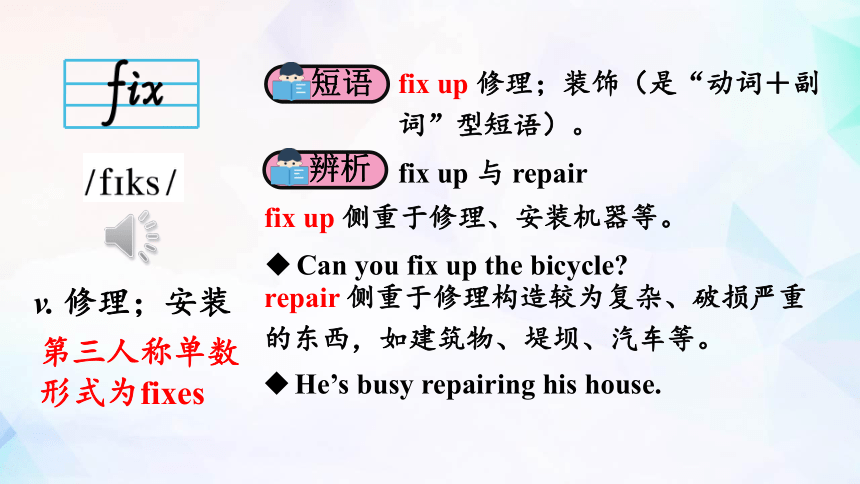

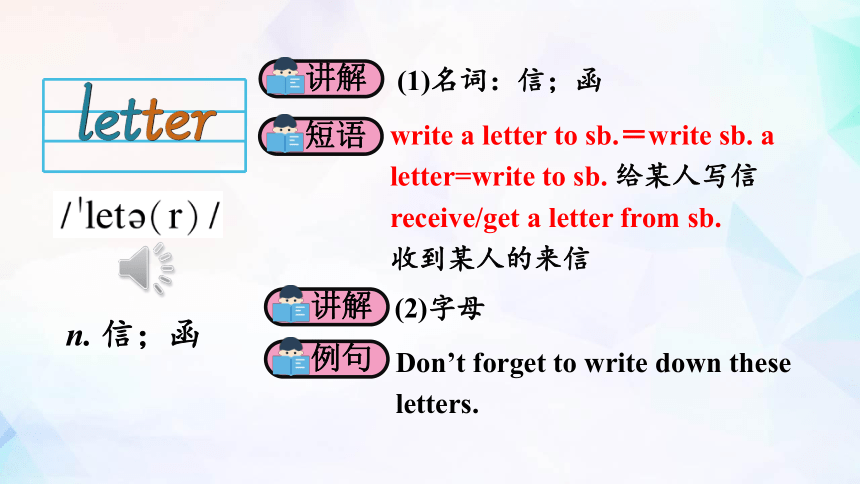
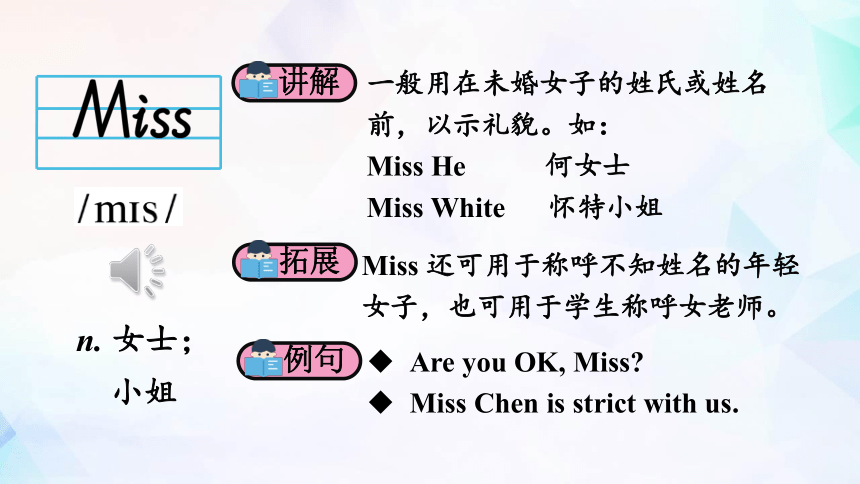
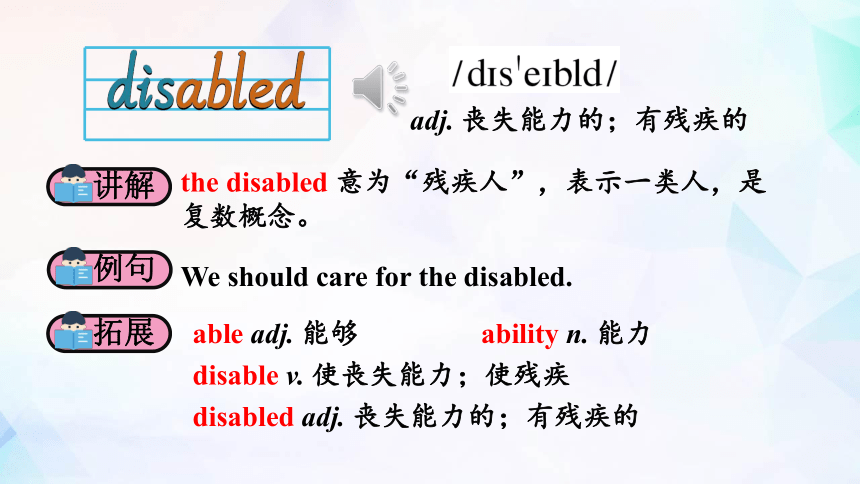
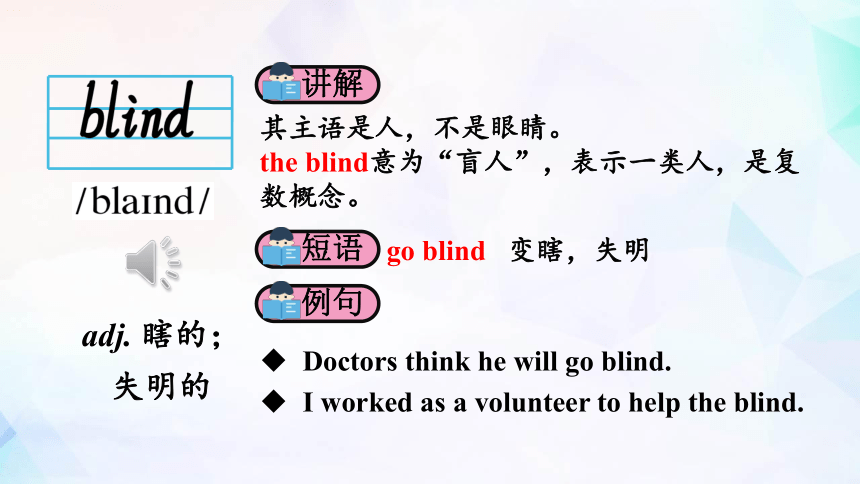
文档简介
(共19张PPT)
Unit 2 I’ll help to clean up the city parks.
Section B
R·八年级下册
第三人称单数形式为fixes
v. 修理;安装
fix up 与 repair
fix up 侧重于修理、安装机器等。
He’s busy repairing his house.
fix up 修理;装饰(是“动词+副词”型短语)。
Can you fix up the bicycle
repair 侧重于修理构造较为复杂、破损严重的东西,如建筑物、堤坝、汽车等。
短语
辨析
adj. 破损的;残缺的
在句中可作定语或表语。
The broken dishes lay on the floor.
(1)动词:(使)破;裂;碎
The plate broke into pieces.
(2)名词:间歇;休息
She worked all day without a break.
break 过去式为broke
讲解
例句
拓展
n. 信;函
(1)名词:信;函
write a letter to sb.=write sb. a letter=write to sb. 给某人写信receive/get a letter from sb.
收到某人的来信
(2)字母
Don’t forget to write down these letters.
讲解
短语
讲解
例句
n. 女士;小姐
一般用在未婚女子的姓氏或姓名前,以示礼貌。如:
Miss He 何女士
Miss White 怀特小姐
Are you OK, Miss
Miss Chen is strict with us.
Miss 还可用于称呼不知姓名的年轻女子,也可用于学生称呼女老师。
讲解
拓展
例句
adj. 丧失能力的;有残疾的
the disabled 意为“残疾人”,表示一类人,是复数概念。
We should care for the disabled.
able adj. 能够 ability n. 能力
disable v. 使丧失能力;使残疾
disabled adj. 丧失能力的;有残疾的
讲解
例句
拓展
adj. 瞎的;失明的
其主语是人,不是眼睛。
the blind意为“盲人”,表示一类人,是复数概念。
Doctors think he will go blind.
I worked as a volunteer to help the blind.
go blind 变瞎,失明
讲解
短语
例句
adj. 聋的
表示某只耳朵失聪要用介词 in。
deaf, blind, poor 等形容词前面加定冠词 the,表示某一类人,是复数概念。示例如下:
The old man is deaf in the left ear.
the deaf 失聪的人 the sick 病人
the blind 盲人 the poor 穷人
the disabled 残疾人
讲解
例句
拓展
v. 想象;设想
imagine+ 名词/代词 想象……
imagine (sb.) doing sth. 想象(某人)做某事imagine+ 从句 想象……
I can’t imagine life without the Internet.
She never imagined living alone in a lonely village.
You can’t imagine that the boy can come up with such a good idea.
讲解
例句
n. 困难;难题
(1)可数名词: 困难;难题。其形容词形式为difficult,意为“困难的”。
We can’t give up when we meet difficulties.
(2)不可数名词: 困难(多指抽象意义上的“困难” )。
have difficulty (in) doing sth. 做某事有困难
Do you have difficulty (in) learning English words
=have trouble/problems (in) learning
讲解
例句
讲解
短语
例句
adj. 开着的
v. 开;打开
(1) 及物动词:开;打开。常指打开原本闭合着的东西, 如门、窗、盒子、书本等。其反义词为close(关;关闭)。
You’d better open the door.
(2) 形容词:开着的;营业。其反义词是closed,意为“关闭
的;停止营业”。
Keep the windows open. It’s a bit hot.
讲解
例句
讲解
例句
过去式:carried
v. 拿;提;扛
carry, take, bring 与 get
carry 拿;提;扛。具有负重的含义,没有方向性。
take 拿走;取走。指把人或物从说话人处带到别处。
bring 取来;带来。指把人或物从别处带到说话人处。
get 去取来。指到某地去把人或物拿来或带来。是双向动作。
辨析
v. 训练;培训
(1)及物动词:训练;培训
train sb./sth. to do sth. 训练某人/某物做某事
train sb. in sth. 在某方面培养或训练某人
(2)不及物动词:训练;接受训练
(3)可数名词:火车
training 不可数名词:训练;培训
讲解
短语
讲解
拓展
adj. 激动的;兴奋的
be excited about… 对……感到兴奋
be excited to do sth. 对做某事感到兴奋
excited 与 exciting
excited 激动的;兴奋的(常作表语,主语通常是人)exciting 使人兴奋的;令人激动的(常作定语或表语,通常修饰事或物)
We are excited about the exciting news.
讲解
辨析
串记
n. 仁慈;善良
kind (adj.善良的)十名词后缀–ness
在英语中,有些形容词加后缀 -ness 可以构成名词,表示性质、状态或特点。示例如下:
happy 愉快的;高兴的→ happiness 高兴;幸福
shy 羞怯的;腼腆的 → shyness 害羞;腼腆
sad 悲伤的;难过的 → sadness 悲伤;悲痛
Thank you for your kindness.
构成
例句
拓展
adj. 聪明的;聪颖的
在句中作定语或表语。
Andrew is a clever boy.
She is so clever and she often gets good grades.
讲解
例句
过去式:understood
v. 理解;领会
既可作及物动词,也可作不及物动词。
It’s much easier to understand the words with the help of the dictionary.
The story is not easy to understand.
讲解
例句
v. & n. 变化;改变
(1)及物动词: 变化;改变
Nothing can make Mary change her mind.
(2)可数名词: 变化;改变
One small change can make a big difference.
(3)不可数名词: 零钱
Here’s your change, sir.
change (…) into… (把……)变成……
讲解
短语
例句
讲解
例句
讲解
例句
n. 兴趣;关注
v. 使感兴趣;使关注
(1)可数名词:兴趣;爱好
have/take an interest in… 对……感兴趣
show an interest in… 对……表现出兴趣
(2)及物动词:使感兴趣;使关注
Music doesn’t interest me.
I have/take an interest in science.
讲解
例句
短语
讲解
例句
Unit 2 I’ll help to clean up the city parks.
Section B
R·八年级下册
第三人称单数形式为fixes
v. 修理;安装
fix up 与 repair
fix up 侧重于修理、安装机器等。
He’s busy repairing his house.
fix up 修理;装饰(是“动词+副词”型短语)。
Can you fix up the bicycle
repair 侧重于修理构造较为复杂、破损严重的东西,如建筑物、堤坝、汽车等。
短语
辨析
adj. 破损的;残缺的
在句中可作定语或表语。
The broken dishes lay on the floor.
(1)动词:(使)破;裂;碎
The plate broke into pieces.
(2)名词:间歇;休息
She worked all day without a break.
break 过去式为broke
讲解
例句
拓展
n. 信;函
(1)名词:信;函
write a letter to sb.=write sb. a letter=write to sb. 给某人写信receive/get a letter from sb.
收到某人的来信
(2)字母
Don’t forget to write down these letters.
讲解
短语
讲解
例句
n. 女士;小姐
一般用在未婚女子的姓氏或姓名前,以示礼貌。如:
Miss He 何女士
Miss White 怀特小姐
Are you OK, Miss
Miss Chen is strict with us.
Miss 还可用于称呼不知姓名的年轻女子,也可用于学生称呼女老师。
讲解
拓展
例句
adj. 丧失能力的;有残疾的
the disabled 意为“残疾人”,表示一类人,是复数概念。
We should care for the disabled.
able adj. 能够 ability n. 能力
disable v. 使丧失能力;使残疾
disabled adj. 丧失能力的;有残疾的
讲解
例句
拓展
adj. 瞎的;失明的
其主语是人,不是眼睛。
the blind意为“盲人”,表示一类人,是复数概念。
Doctors think he will go blind.
I worked as a volunteer to help the blind.
go blind 变瞎,失明
讲解
短语
例句
adj. 聋的
表示某只耳朵失聪要用介词 in。
deaf, blind, poor 等形容词前面加定冠词 the,表示某一类人,是复数概念。示例如下:
The old man is deaf in the left ear.
the deaf 失聪的人 the sick 病人
the blind 盲人 the poor 穷人
the disabled 残疾人
讲解
例句
拓展
v. 想象;设想
imagine+ 名词/代词 想象……
imagine (sb.) doing sth. 想象(某人)做某事imagine+ 从句 想象……
I can’t imagine life without the Internet.
She never imagined living alone in a lonely village.
You can’t imagine that the boy can come up with such a good idea.
讲解
例句
n. 困难;难题
(1)可数名词: 困难;难题。其形容词形式为difficult,意为“困难的”。
We can’t give up when we meet difficulties.
(2)不可数名词: 困难(多指抽象意义上的“困难” )。
have difficulty (in) doing sth. 做某事有困难
Do you have difficulty (in) learning English words
=have trouble/problems (in) learning
讲解
例句
讲解
短语
例句
adj. 开着的
v. 开;打开
(1) 及物动词:开;打开。常指打开原本闭合着的东西, 如门、窗、盒子、书本等。其反义词为close(关;关闭)。
You’d better open the door.
(2) 形容词:开着的;营业。其反义词是closed,意为“关闭
的;停止营业”。
Keep the windows open. It’s a bit hot.
讲解
例句
讲解
例句
过去式:carried
v. 拿;提;扛
carry, take, bring 与 get
carry 拿;提;扛。具有负重的含义,没有方向性。
take 拿走;取走。指把人或物从说话人处带到别处。
bring 取来;带来。指把人或物从别处带到说话人处。
get 去取来。指到某地去把人或物拿来或带来。是双向动作。
辨析
v. 训练;培训
(1)及物动词:训练;培训
train sb./sth. to do sth. 训练某人/某物做某事
train sb. in sth. 在某方面培养或训练某人
(2)不及物动词:训练;接受训练
(3)可数名词:火车
training 不可数名词:训练;培训
讲解
短语
讲解
拓展
adj. 激动的;兴奋的
be excited about… 对……感到兴奋
be excited to do sth. 对做某事感到兴奋
excited 与 exciting
excited 激动的;兴奋的(常作表语,主语通常是人)exciting 使人兴奋的;令人激动的(常作定语或表语,通常修饰事或物)
We are excited about the exciting news.
讲解
辨析
串记
n. 仁慈;善良
kind (adj.善良的)十名词后缀–ness
在英语中,有些形容词加后缀 -ness 可以构成名词,表示性质、状态或特点。示例如下:
happy 愉快的;高兴的→ happiness 高兴;幸福
shy 羞怯的;腼腆的 → shyness 害羞;腼腆
sad 悲伤的;难过的 → sadness 悲伤;悲痛
Thank you for your kindness.
构成
例句
拓展
adj. 聪明的;聪颖的
在句中作定语或表语。
Andrew is a clever boy.
She is so clever and she often gets good grades.
讲解
例句
过去式:understood
v. 理解;领会
既可作及物动词,也可作不及物动词。
It’s much easier to understand the words with the help of the dictionary.
The story is not easy to understand.
讲解
例句
v. & n. 变化;改变
(1)及物动词: 变化;改变
Nothing can make Mary change her mind.
(2)可数名词: 变化;改变
One small change can make a big difference.
(3)不可数名词: 零钱
Here’s your change, sir.
change (…) into… (把……)变成……
讲解
短语
例句
讲解
例句
讲解
例句
n. 兴趣;关注
v. 使感兴趣;使关注
(1)可数名词:兴趣;爱好
have/take an interest in… 对……感兴趣
show an interest in… 对……表现出兴趣
(2)及物动词:使感兴趣;使关注
Music doesn’t interest me.
I have/take an interest in science.
讲解
例句
短语
讲解
例句
同课章节目录
- Unit 1 What's the matter?
- Section A
- Section B
- Unit 2 I'll help to clean up the city parks.
- Section A
- Section B
- Unit 3 Could you please clean your room?
- Section A
- Section B
- Unit 4 Why don't you talk to your parents?
- Section A
- Section B
- Unit 5 What were you doing when the rainstorm came
- Section A
- Section B
- Review of Units 1-5
- Unit 6 An old man tried to move the mountains.
- Section A
- Section B
- Unit 7 What's the highest mountain in the world?
- Section A
- Section B
- Unit 8 Have you read Treasure Island yet?
- Section A
- Section B
- Unit 9 Have you ever been to a museum?
- Section A
- Section B
- Unit 10 I've had this bike for three years.
- Section A
- Section B
